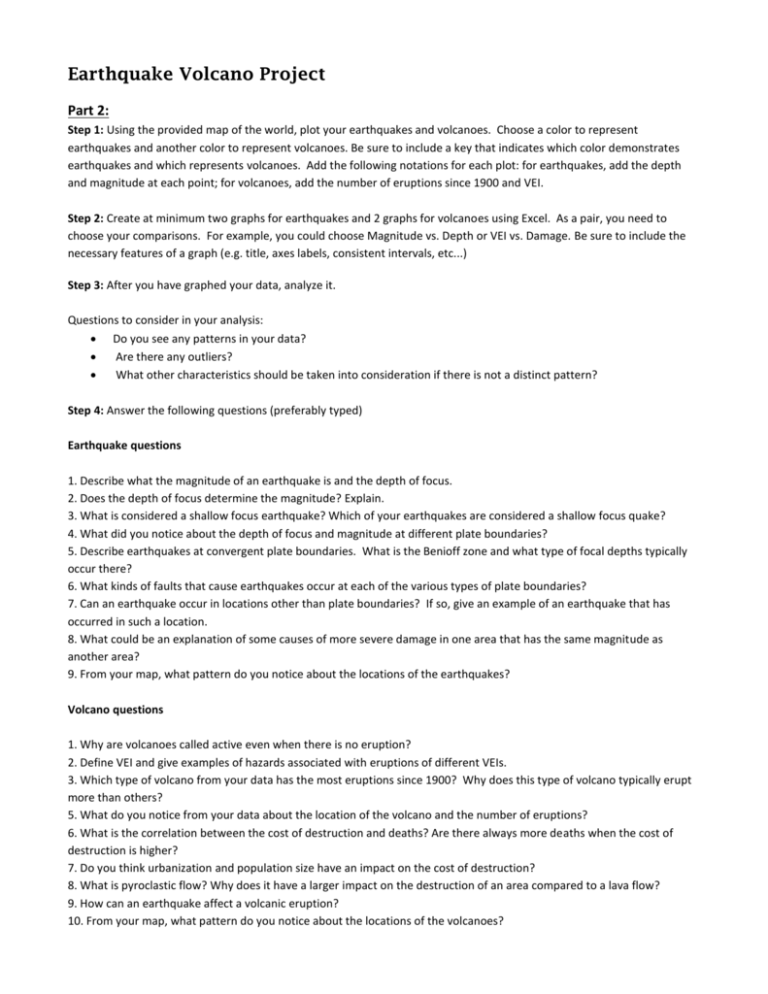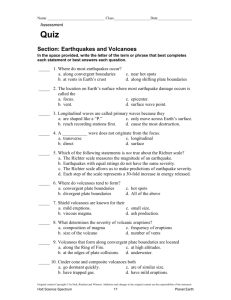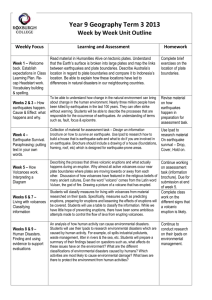Earthquake Volcano Project_Part 2
advertisement

Earthquake Volcano Project Part 2: Step 1: Using the provided map of the world, plot your earthquakes and volcanoes. Choose a color to represent earthquakes and another color to represent volcanoes. Be sure to include a key that indicates which color demonstrates earthquakes and which represents volcanoes. Add the following notations for each plot: for earthquakes, add the depth and magnitude at each point; for volcanoes, add the number of eruptions since 1900 and VEI. Step 2: Create at minimum two graphs for earthquakes and 2 graphs for volcanoes using Excel. As a pair, you need to choose your comparisons. For example, you could choose Magnitude vs. Depth or VEI vs. Damage. Be sure to include the necessary features of a graph (e.g. title, axes labels, consistent intervals, etc...) Step 3: After you have graphed your data, analyze it. Questions to consider in your analysis: Do you see any patterns in your data? Are there any outliers? What other characteristics should be taken into consideration if there is not a distinct pattern? Step 4: Answer the following questions (preferably typed) Earthquake questions 1. Describe what the magnitude of an earthquake is and the depth of focus. 2. Does the depth of focus determine the magnitude? Explain. 3. What is considered a shallow focus earthquake? Which of your earthquakes are considered a shallow focus quake? 4. What did you notice about the depth of focus and magnitude at different plate boundaries? 5. Describe earthquakes at convergent plate boundaries. What is the Benioff zone and what type of focal depths typically occur there? 6. What kinds of faults that cause earthquakes occur at each of the various types of plate boundaries? 7. Can an earthquake occur in locations other than plate boundaries? If so, give an example of an earthquake that has occurred in such a location. 8. What could be an explanation of some causes of more severe damage in one area that has the same magnitude as another area? 9. From your map, what pattern do you notice about the locations of the earthquakes? Volcano questions 1. Why are volcanoes called active even when there is no eruption? 2. Define VEI and give examples of hazards associated with eruptions of different VEIs. 3. Which type of volcano from your data has the most eruptions since 1900? Why does this type of volcano typically erupt more than others? 5. What do you notice from your data about the location of the volcano and the number of eruptions? 6. What is the correlation between the cost of destruction and deaths? Are there always more deaths when the cost of destruction is higher? 7. Do you think urbanization and population size have an impact on the cost of destruction? 8. What is pyroclastic flow? Why does it have a larger impact on the destruction of an area compared to a lava flow? 9. How can an earthquake affect a volcanic eruption? 10. From your map, what pattern do you notice about the locations of the volcanoes?











